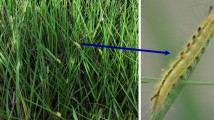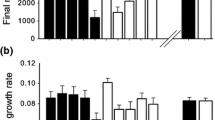Abstract
Invasive plants generally escape from specialist herbivores of their native ranges but may experience serious damage from generalists. As a result, invasive plants may evolve increased resistance to generalists and tolerance to damage. To test these hypotheses, we carried out a common garden experiment comparing 15 invasive populations with 13 native populations of Chromolaena odorata, including putative source populations identified with molecular methods and binary choice feeding experiments using three generalist herbivores. Plants from invasive populations of C. odorata had both higher resistance to three generalists and higher tolerance to simulated herbivory (shoot removal) than plants from native populations. The higher resistance of plants from invasive populations was associated with higher leaf C content and densities of leaf trichomes and glandular scales, and lower leaf N and water contents. Growth costs were detected for tolerance but not for resistance, and plants from invasive populations of C. odorata showed lower growth costs of tolerance. Our results suggest that invasive plants may evolve to increase both resistance to generalists and tolerance to damage in introduced ranges, especially when the defense traits have low or no fitness costs. Greater defenses in invasive populations may facilitate invasion by C. odorata by reducing generalist impacts and increasing compensatory growth after damage has occurred.




Similar content being viewed by others
References
Abhilasha D, Joshi J (2009) Enhanced fitness due to higher fecundity, increased defence against a specialist and tolerance towards a generalist herbivore in an invasive annual plant. J Plant Ecol 2:77–86
Agrawal AA, Strauss SY, Stout MJ (1999) Costs of induced responses and tolerance to herbivory in male and female fitness components of wild radish. Evolution 53:1093–1104
Agrawal AA, Kotanen PM, Mitchell CE, Power AG, Godsoe W, Klironomos J (2005) Enemy release? An experiment with congeneric plant pairs and diverse above- and belowground enemies. Ecology 86:2979–2989
Alba C, Hufbauer R (2012) Exploring the potential for climatic factors, herbivory, and co-occurring vegetation to shape performance in native and introduced populations of Verbascum thapsus. Biol Invas 14:2505–2518
Alba C, Bowers MD, Blumenthal D, Hufbauer R (2011) Evolution of growth but not structural or chemical defense in Verbascum thapsus (common mullein) following introduction to North America. Biol Invas 13:2379–2389
Belsky AJ, Carson WP, Jensen CL, Fox GA (1993) Overcompensation by plants: herbivore optimization or red herring? Evol Ecol 7:109–121
Blossey B, Nötzold R (1995) Evolution of increased competitive ability in invasive nonindigenous plants: a hypothesis. J Ecol 83:887–889
Bossdorf O, Schroder S, Prati D, Auge H (2004) Palatability and tolerance to simulated herbivory in native and introduced populations of Alliaria petiolata (Brassicaceae). Am J Bot 91:856–862
Caño L, Escarré J, Vrieling K, Sans FX (2009) Palatability to a generalist herbivore, defence and growth of invasive and native Senecio species: testing the evolution of increased competitive ability hypothesis. Oecologia 159:95–106
Cripps MG, Hinz HL, McKenney JL, Price WJ, Schwarzländer M (2009) No evidence for an ‘evolution of increased competitive ability’ for the invasive Lepidium draba. Basic Appl Ecol 10:103–112
Dlugosch KM, Parker IM (2008) Invading populations of an ornamental shrub show rapid life history evolution despite genetic bottlenecks. Ecol Lett 11:701–709
Feng Y-L, Lei Y-B, Wang R-F, Callaway RM, Valiente-Banuet A, Inderjit S, Li Y-P, Zheng Y-L (2009) Evolutionary tradeoffs for nitrogen allocation to photosynthesis versus cell walls in an invasive plant. Proc Natl Acad Sci USA 106:1853–1856
Fine PVA, Miller ZJ, Mesones I, Irazuzta S, Appel HM, Stevens MHH, Sääksjärvi I, Schultz LC, Coley PD (2006) The growth-defense trade-off and habitat specialization by plants in Amazonian forests. Ecology 87:S150–S162
Flory SL, Long F, Clay K (2011) Invasive microstegium populations consistently outperform native range populations across diverse environments. Ecology 92:2248–2257
Fornoni J (2011) Ecological and evolutionary implications of plant tolerance to herbivory. Funct Ecol 25:399–407
Fukano Y, Yahara T (2012) Changes in defense of an alien plant Ambrosia artemisiifolia before and after the invasion of a native specialist enemy Ophraella communa. PLoS One 7:e49114
Huang W, Siemann E, Wheeler GS, Zou J, Carrillo J, Ding J (2010) Resource allocation to defence and growth are driven by different responses to generalist and specialist herbivory in an invasive plant. J Ecol 98:1157–1167
Joshi J, Vrieling K (2005) The enemy release and EICA hypothesis revisited: incorporating the fundamental difference between specialist and generalist herbivores. Ecol Lett 8:704–714
Kluge RL, Caldwell PM (1992) Phytophagous insects and mites on Chromolaena odorata (Compositae, Eupatoreae) in Southern Africa. J Entomol Soc South Afr 55:159–161
Koutika LS, Rainey HJ (2010) Chromolaena odorata in different ecosystems: weed or fallow plant? Appl Ecol Environ Res 8:131–142
Kriticos DJ, Yonow T, McFadyen RE (2005) The potential distribution of Chromolaena odorata (Siam weed) in relation to climate. Weed Res 45:246–254
Leger EA, Forister ML (2005) Increased resistance to generalist herbivores in invasive populations of the california poppy (Eschscholzia californica). Divers Distrib 11:311–317
Lennartsson T, Tuomi J, Nilsson P (1997) Evidence for an evolutionary history of overcompensation in the grassland biennial Gentianella campestris (Gentianaceae). Am Nat 149:1147–1155
Li Y-P, Feng Y-L, Barclay G (2012) No evidence for evolutionarily decreased tolerance and increased fitness in invasive Chromolaena odorata: implications for invasiveness and biological control. Plant Ecol 213:1157–1166
Maron JL, Vilà M, Arnason J (2004) Loss of enemy resistance among introduced populations of St. John’s wort (Hypericum perforatum). Ecology 85:3243–3253
McFadyen R (1988) Phytophagous insects recorded from C. odorata. Chromolaena odorata Newsl 2:5–23
Müller C, Martens N (2005) Testing predictions of the ‘evolution of increased competitive ability’ hypothesis for an invasive crucifer. Evol Ecol 19:533–550
Müller-Schärer H, Schaffner U, Steinger T (2004) Evolution in invasive plants: implications for biological control. Trends Ecol Evol 19:417–422
Oduor AMO, Lankau RA, Strauss SY, Gomez JM (2011) Introduced Brassica nigra populations exhibit greater growth and herbivore resistance but less tolerance than native populations in the native range. New Phytol 191:536–544
Parker JD, Torchin ME, Hufbauer RA, Lemoine NP, Alba C, Blumenthal DM, Bossdorf O, Byers JE, Dunn AM, Heckman RW, Hejda M, Jarošík V, Kanarek AR, Martin LB, Perkins SE, Pyšek P, Schierenbeck K, Schlöder C, van Klinken R, Vaughn KJ, Williams W, Wolfe LM (2013) Do invasive species perform better in their new ranges? Ecology 94:985–994
Qin R-M, Zheng Y-L, Valiente-Banuet A, Callaway RM, Barclay GF, Silva Pereyra C, Feng Y-L (2013) The evolution of increased competitive ability, innate competitive advantages, and novel biochemical weapons act in concert for a tropical invader. New Phytol 197:979–988
Scott LJ, Lange CL, Graham GC, Yeates DK (1998) Genetic diversity and origin of siam weed (Chromolaena odorata) in Australia. Weed Technol 12:27–31
Siemann E, Rogers WE (2003) Reduced resistance of invasive varieties of the alien tree Sapium sebiferum to a generalist herbivore. Oecologia 135:451–457
Siemens DH, Garner SH, Mitchell-Olds T, Callaway RM (2002) Cost of defense in the context of plant competition: Brassica rapa may grow and defend. Ecology 83:505–517
Simms EL, Triplett J (1994) Costs and benefits of plant-responses to disease: resistance and tolerance. Evolution 48:1973–1985
Strauss SY, Agrawal AA (1999) The ecology and evolution of plant tolerance to herbivory. Trends Ecol Evol 14:179–185
te Beest M, Cromsigt JPGM, Ngobese J, Olff H (2012) Managing invasions at the cost of native habitat? An experimental test of the impact of fire on the invasion of Chromolaena odorata in a South African savanna. Biol Invas 14:607–618
Uesugi A, Kessler A (2013) Herbivore exclusion drives the evolution of plant competitiveness via increased allelopathy. New Phytol 198:916–924
Von Senger I, Barker N, Zachariades C (2002) Preliminary phylogeography of Chromolaena odorata: finding the origin of a South African weed. In: Zachariades C, Muniappan R, Strathie LW (eds) Proceedings of the Fifth International Workshop on Biological Control and Management of Chromolaena odorata. ARC-Plant Protection Research Institute, Durban, pp 90–99
Wang Y, Huang W, Siemann E, Zou JW, Wheeler GS, Carrillo J, Ding JQ (2011) Lower resistance and higher tolerance of invasive host plants: biocontrol agents reach high densities but exert weak control. Ecol Appl 21:729–738
Wolfe LM, Elzinga JA, Biere A (2004) Increased susceptibility to enemies following introduction in the invasive plant Silene latifolia. Ecol Lett 7:813–820
Xu J, Xiang CL, Chen L, Peng H (2011) Orthezia quadrua (Homoptera: Ortheziidae): a natural enemy of Ageratina adenophora and Chromolaena odorata. J Yunn Agric Univ 26:577–579
Yamawo A, Hada Y (2010) Effects of light on direct and indirect defences against herbivores of young plants of Mallotus japonicus demonstrate a trade-off between two indirect defence traits. Ann Bot 106:143–148
Zhang LH, Feng YL (2007) Potential biological control agents of Chromolaena odorata. Chin J Biol Contr 23:83–88
Zou JW, Siemann E, Rogers WE, DeWalt SJ (2008) Decreased resistance and increased tolerance to native herbivores of the invasive plant Sapium sebiferum. Ecography 31:663–671
Acknowledgments
We are grateful to Dr. Franklin Axelrod, Gregor F. Barclay, Tran Xuan Cuong, Dao-Ling Du, Carmelita Garcia-Hansel, Inderjit, Daphawan Khamcha, Jorge A. Sánchez, Ravi Sangakkara, Tuanjit Sritongchuay, Alfonso Valient-Banuet, Steven W. Woodmansee, Chang-Long Zhang, and Xiao-Ming Zou for collecting the seeds, Dr. De-Niu Chen for identifying the snail species, and the staff of the Biogeochemistry Laboratory of the Xishuangbanna Tropical Botanical Garden for measuring the leaf nutrient concentrations. This study was financially supported by the National Natural Science Foundation of China (30830027; 31270582). The experiments comply with the current laws of the country in which the experiments were performed.
Author information
Authors and Affiliations
Corresponding author
Additional information
Communicated by Jennifer A Lau.
Electronic supplementary material
Below is the link to the electronic supplementary material.
Rights and permissions
About this article
Cite this article
Liao, ZY., Zheng, YL., Lei, YB. et al. Evolutionary increases in defense during a biological invasion. Oecologia 174, 1205–1214 (2014). https://doi.org/10.1007/s00442-013-2852-z
Received:
Accepted:
Published:
Issue Date:
DOI: https://doi.org/10.1007/s00442-013-2852-z




